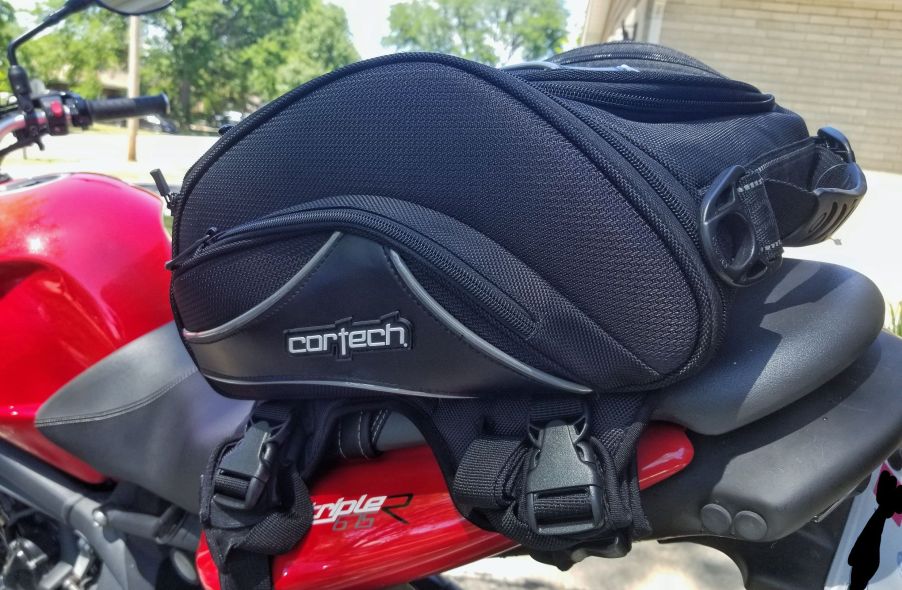
What Are the Best Ways to Carry Luggage on Your Motorcycle?
Whether you’re going camping on your motorcycle or for a simple long-distance ride, sometimes you need more than just your safety gear and some gas. But while some bikes have built-in storage areas, the available space tends to be limited. That’s why dedicated motorcycle luggage is a common sight on many bikes, especially touring and adventure ones. And while picking between the sheer number of available options may seem daunting, it just requires keeping a few things in mind.
Picking your motorcycle luggage is about more than carrying capacity

Riders buy motorcycle luggage so they can carry more things on their bikes at one time. But while adding storage space is theoretically as easy as attaching another bag, in reality, it’s a bit more complicated than that.
Firstly, just like cars and trucks, motorcycles have Gross Vehicle Weight Ratings, RevZilla explains. A bike’s GVWR limits how much weight it can safely carry. Exceed it, and you can crack a sub-frame or worse. So, even if you have large bags, the extra space is useless with a small GVWR.
Secondly, your motorcycle luggage options are limited by what mounting systems your bike accepts. Some bobbers, for example, lack rear fenders, eliminating fender-mounted racks from consideration. However, that doesn’t mean you can’t add a universal bracket or bag-specific adapter to your motorcycle. But before you do, check to see if your bike is compatible and that the adapter/mount doesn’t obstruct anything. Say, for instance, the exhaust pipes.
Thirdly, know what you’ll use your motorcycle luggage for, where you’ll go, and how often. Yes, towing a trailer with your motorcycle is a great way to carry more gear. But you wouldn’t want to take one on an overlanding route. Also, some luggage racks/mounts are permanent installs, while others are removable, RevZilla notes. If you only carry bags on your motorcycle a few times a year, the latter doesn’t leave you riding around with a bare rack the rest of the time.
Speaking of riding, that’s another point worth considering with motorcycle luggage. You need to be comfortable riding the gear-loaded bike. That means making sure the bags aren’t impeding your movement. And it also means distributing the weight evenly to keep your bike stable at all speeds, Motorcyclist explains.
Soft motorcycle bags aren’t the only or always the best luggage option
Although ‘motorcycle luggage’ often translates to ‘bags,’ that’s only one luggage category, Motorcyclist explains. And while rear-mounted bags are a common accessory on ADVs, they’re not the only kinds of bags available.
Motorcycle bags fall into two broad categories: saddlebags and tank bags. The former mount on the rear of the bike and/or on top of the seat, hence the term ‘saddlebag.’ Top-mounted saddlebags are also sometimes called ‘tail bags.’
Tank bags aren’t as large as saddlebags. But because they’re mounted right in front of the rider, they’re easier to access, RevZilla explains. However, if you want to refuel your bike, you’ll have to temporarily remove them. Luckily, some bags have quick-release mounts or are magnetic, making dismounting/remounting easier.
Whether saddlebag or tank bag, motorcycle bags also fall into ‘hard’ and ‘soft’ categories depending on their construction. Hard bags, made of composite, metal, or plastic, are easier to lock and secure. They also tend to be more weather-proof. However, they’re usually heavier and more difficult to remove if you need to transport them, Motorcyclist notes. Hard motorcycle luggage also tends to be more bike-specific, due to the clearance needs noted earlier.

Soft motorcycle bags aren’t necessarily as durable as hard ones. However, even if they’re not waterproof, they often have rain covers to protect them from the elements. And because vinyl, rubber, fabric, and leather are more malleable than plastic, these bags are easier to mount. Instead of a rack, the tail bag on my Street Triple R uses Velcro and straps, for example. Plus, soft bags are expandable, while most hard ones aren’t, Motorcyclist points out.
However, if you’re not carrying much gear, or carry it infrequently, there is one more motorcycle luggage option: a backpack. A dedicated motorcycle backpack offers durable materials, weather-proofing and/or a rain cover, and an ergonomic design, RevZilla explains. Some also have reflective elements and helmet carriers. And while they’re not as roomy as some bags, they’re arguably more convenient.
Does it have to be expensive?
Buying motorcycle luggage won’t necessarily break your wallet, but certain features come with added costs. For example, hard saddlebags tend to be pricier than soft ones; lockable tank bags are more expensive than non-lockable ones. And as noted earlier, some bags require additional brackets or adapters. Though with some soft bags, you can get away with bungee-cording them in place, RideApart notes.
As a point of reference, I paid $125 for my Cortech Super 2.0 Tail Bag. A pair of soft saddlebags for my Street Triple R typically costs around $150-$200 if they don’t need racks. A waterproof tank bag can cost anywhere from $70-$250, depending on its construction, attachment method, and additional features. And if you want a proper motorcycle backpack, prepare to spend at least $100.

It’s worth noting that not every rider needs every piece of motorcycle luggage. If you don’t bring many things on your rides, a backpack or a tank bag might be all you need. And pavement-only riders don’t need hard saddlebags. In short, the best ways of carrying luggage on your motorcycle are the ones that fit your lifestyle.
Follow more updates from MotorBiscuit on our Facebook page.


